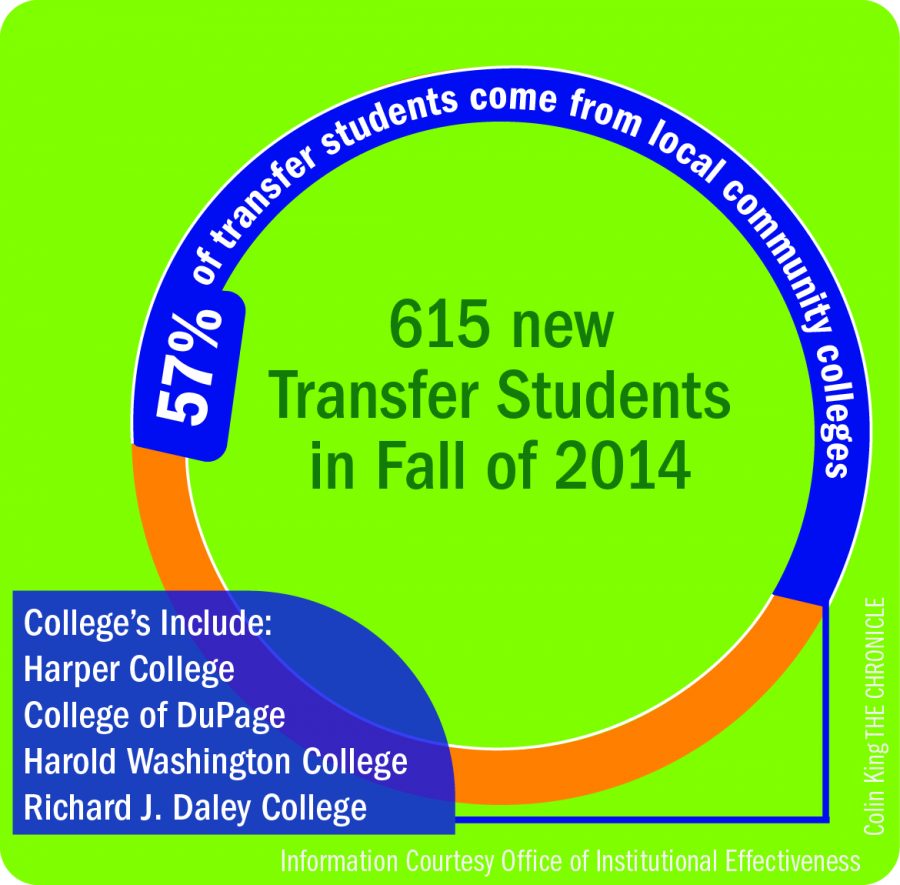College to increase focus on transfer students, initiatives
College to increase focus on transfer students, initiatives
April 13, 2015
Local community colleges that provide free tuition to incoming students may affect Columbia’s transfer enrollment.
Harper College, a suburban community college that partners with Columbia in its recruiting initiatives, announced March 29 the creation of a Promise Scholarship program that provides two free years of tuition to current high school students. This initiative follows the fall 2014 announcement of the Chicago STAR scholarship, which promises a paid-for tuition at City Colleges of Chicago to eligible Chicago Public Schools students.
Newly implemented scholarship programs such as Promise and STAR could impact transfer student enrollment at Columbia, according to Keri Walters, assistant dean of Faculty Advising in the School of Fine and Performing Arts and assistant to the provost for Transfer Initiatives.
In the Fall 2014 Semester, 615 new transfer students came to the college with 57 percent of the total number of transfer students coming from local community colleges, Walters said.
“How many students will qualify for the free tuition remains to be seen,” Walters said. “Any kind of talk about free tuition—[the college] has to be concerned about it. We have to think about that because it’s important for us as an institution to prepare for an influx of community college students and prepare for the possibility that that becomes much more the norm for students who want to take advantage of [free tuition] and start at a community college, save money and then come here and complete their latter two years.”
Walters said because of the STAR program eligibility requirements, including a high GPA level and college-ready test scores in math and English, the scholarships will only affect a small population of students, so it is difficult to determine how they could affect transfer student enrollment.
Walters said she has been advocating for a plan to increase transfer enrollment and is excited the Strategic Plan draft released March 23 mirrors that goal by adding new positions and initiatives dedicated to transfers. The college’s transfer numbers have declined at greater rates than the four-year student population due to a former administrator’s policy not allowing the college to automatically accept coursework from other institutions, which hurt the college’s ability to recruit transfer students, Walters said.
“It’s something that is healthy as a four-year institution for us to increase that transfer population so it’s back at that healthy level where it was previously,” Walters said.
Brian Marth, director of the College Advising Center, said he hopes to see the opportunity for free community college cause an influx in transfer students because the number of students choosing to complete their first two years at a less expensive institution is increasing.
“What the Strategic Plan is referencing is let’s look at our relationships with those partner institutions so they know we’re here and we’re a good option for them,” Marth said. “Let’s try to look at our policies and procedures for transfer students to make sure that it’s transfer friendly.”
Marth added that one way the college can improve its transfer initiatives would be to make it clear to students whether their degree can realistically be completed in two years. The college recently created transfer plans that help students understand how long their degree will take to complete, according to Walters.
“Some of our programs—probably about half—are doable within a two-year time frame, and that’s very attractive for transfers,” Walters said. “But we have other programs that are more like three years and we even have some programs that take all eight semesters. We consider those to be not transferrable. We’re not going to deny students access to those programs, but if a transfer student chooses to enroll in one of those programs, the transfer plans are designed to help them understand upfront.”
Maggie Lancaster, a senior journalism major who transferred to Columbia her junior year, said Columbia could have better helped her understand what classes she needed to take in order to graduate on time.
“I don’t think my schedule was being optimized to be out in two years,” Lancaster said. “I will graduate in December, but I know that’s not the case for a few of my friends.”
Samuel Flannigan, a sophomore business & entrepreneurship major and a transfer student, said he thinks the administration needs to focus less on transfer enrollment and make a stronger effort to help students complete their programs.
“I don’t see their overall goal of getting people degrees, Flannigan said. “I see it as getting more people here.”
Marth said a rise in transfer enrollment could mean different things for individual students.
“In some ways, you’ll have students coming in who know what they want to do,” Marth said. “On the other [hand], if you have a student who is going to be here for two years, we have to look at services so that student gets a good Columbia experience. It’s not a bad thing, but it speeds up the process.”








